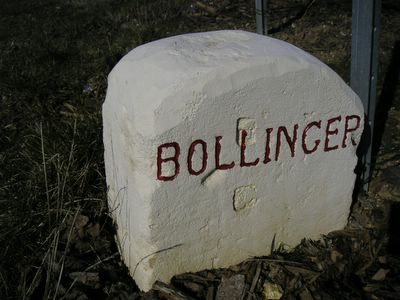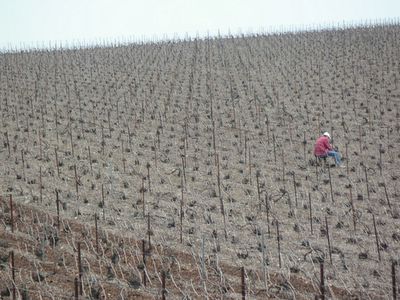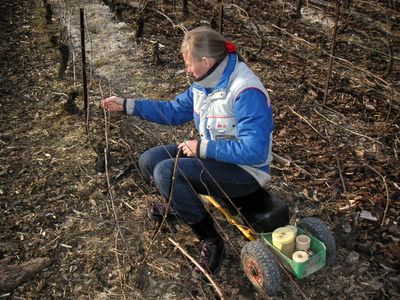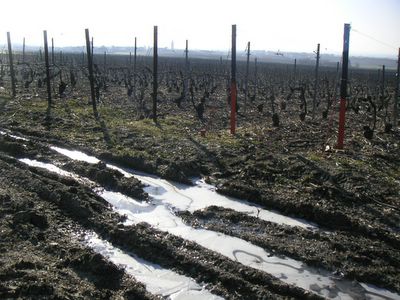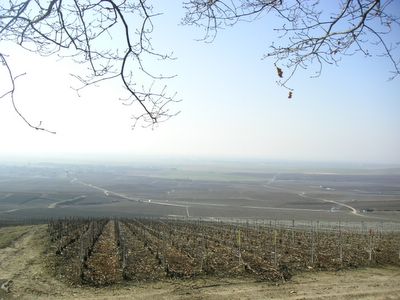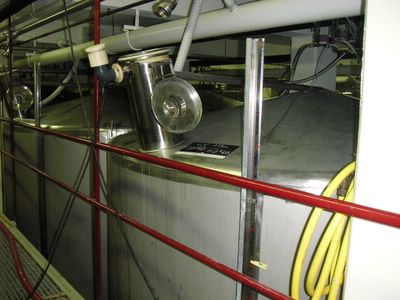 Pinot Noir at Verzy in the Montagne de Reims. The cordon is or are the old, thick branches. These vines are still not pruned.
Pinot Noir at Verzy in the Montagne de Reims. The cordon is or are the old, thick branches. These vines are still not pruned.To prune or not to prune... it has become a lot more fun to enter the vineyards and have your daily five centimeter layer of mud sticked under your boots.
It is not just me, the whole group seems a lot more relaxed, able to tune better and faster into the vines and prune them. Just like that. Everybody works better and faster now. The most obvious sign of enhanced well-being is that more find the necessary extra mental energy to fool a bit about with one another, and actually that is quite new in this group of people. Until now almost everybody has been far too occupied with their vines and
secateurs to find the time to tease the neighbours.
One explanation is that we simply have become better. The other, that this second way of pruning that we have now begun to deal with - the
Cordon de Royat - is a bit more easy than the
Chablis. My guess: A combination. As a Dane after all I am brought up to seek compromise rather than extremes.
Sun in the slopes of Avenay val d'OrThe school in Avize owns seven hectares of vine, but needs 15 to ensure that all students get enough practise in pruning. The lacking eights hectares they find through deals with different
vignerons. These will thus get their pruning for free, performed by normally quite careful students, but still with the risk of mistakes, even serious ones. "Éliminatoire", as our teacher, Stéphanie, never fails to comment with her constant focus on the exams. Now in four weeks.
It is the adults amongst the students that will be send off to the most distant plots - after all we have cars - and this is why we descend a slope at Avenay val d'Or - a small
Premier Cru village on the southern slopes of the Montagne de Reims - on this sunny Thursday afternoon.
An elderly man accompagnies us dressed up in the green parka of the vineyard workers and heavy boots to show us his
cordons. They grow between iron posts, placed with a regularity as the wind blows. Very unlike the normally almost military presicion you will find in most vineyards in Champagne. Now, it is not that they are more slobby in Avenay val d'Or than elsewhere. The irregularity made it more easy to perform the necessary manoeuvres with the plough in the old days, and since then the system was kept, explains the owner.
He stays with us all afternoon. You could get the thought that he - with his long experience - could prune just about the same as we do in those two hours we spend in his plot. But maybe he likes to have a visit, maybe he spots a good future wineworker or two.
The terrain is tough. We begin in the bottom of the plot and prune our way upwards. So even the rows are rather short, I have to stop after arriving at the top. It is physically very challenging for me to move up with my rather muddy basket, that makes our host look at me in a rather suspicious way until he gets the explanation. My pregnancy makes me loose energy too fast if I must bend all the time. And since we cannot take the
camionette each Thursday, I have come up with this basket-solution for the time-being.
The other little plot of the day I have to skip. Which makes me miss the end of the day -
un petit coup - from the local cooperative, where the owner delivers his grapes. Sad, since it is always interesting to taste another champagne.
Principles of the CordonsAvenay val d'Or is placed in the Montagne de Reims, and here Pinot Noir is the main type of vine in the vineyards. Since this is a
Premier Cru-area the winegrowers can choose between the
Chablis-pruning and the
Cordon de Royat-pruning. For Pinot Noir you normally go for the latter, which is the method we are here to practise.
It complies with more or less the same principles as the
Chablis. One trap you must take care of though. A
Cordon is old wood, that year by year grow some centimeters. However only shoots from the growth of last year - the
prolongement or the
coursons that is - will surely carry grapes. Therefor it is quite decisive that you are able to distinguish one from the other when you prune.
The method of the
Cordon de Royat is, that you first cut your
rachet - the little branch with two buds at the bottom of the stem. Already known from the
Chablis as the rejuvenation of the vine.
 Cordon-pruned Pinot Noir with prolongement and coursons.
Cordon-pruned Pinot Noir with prolongement and coursons.
No lancement, as it seems there is enough room for the growth of the plant. It must grow directly from the stem and cut on as pretty a shoot as your available choice permits. We always long for
un beau bois. Reality and theory however can sometimes be of a distance of what seems lightyears apart. When this is the case, all we can do is to say a prayer that the little weak one will grow stronger during the growth season. We may even help it a bit by removing one of the buds, thus only one will remain. This will allow the survivor to be fed better.
Next stop is to prune your
prolongement. Like in the case of the
Chablis-method you choose a branch from last year in a position at the end of the
cordon. This is where we will pick the next grapes. At pruning time next year this
prolongement will have grown into an integrated part of the
cordon, and by then it is no longer fertile. Year by year the
prolongement will thus gradually extend the
cordon a little more.
One thing we must watch though. Like in the
Chablis-method the neighbouring plant has to be kept quiet. The
prolongement is not allowed to interfere in any way with branches of the next plant. If this is the case, and no rejuvenation is in place - more on this later - the first possibility is to shorten the
prolongement with one bud and check if that solves the problem of
chevauchement. If not the whole
cordon must be shortened all the way up to the last
courson . This decision means, that the plant this year will give less grapes than it ought to. On the other hand it will save some power on the removed
prolongement, that it can use on growing a nice
lancement instead.
 Cordon de Royat with rejuvenation coming up. The old cordon will probably be removed at next years pruning.
Cordon de Royat with rejuvenation coming up. The old cordon will probably be removed at next years pruning.Now has come the time to think about rejuvenation of the vine. The criteria is the length of the
cordon plus
prolongement. If these two covers more than two thirds of the entire length of the vine, time is up to prune a
lancement on the
rachet of last year in a length of one bud above the thread. Unlike the
Chablis the number of buds is not regulated. It is
illemité. During the next years this branch will grow into the next, vigorous
cordon.
At the next pruning you will cut a
prolongement on this new
lancement, you will bend it towards the wire and attach it there. When the young
cordon has reached a length of two thirds of the old one, the veteran will finally be removed completely. The process is called
rajeunissement progressif - stepwise rejuvenation that is.
You are allowed to renew only 20 percent of your
cordon-pruned vines each year. You cannot renew – cut a
lancement - the year you remove an old
cordon. The first is to ensure the production of grapes, the second to spare the plant.
Coursons of the cordonThe last thing to do in the stepwise and systematic method of pruning a
cordon is to deal with the
coursons. You start with those on the younger
cordon should you have one, and finish with those on the old
cordon.
Coursons are very short branches that have been cut in a height of two buds in case of Pinot Noir or Pinot Meunier, and three if it is Chardonnay. These short branches must grow on top of the
cordon. In case of emergencies on the side – this is obvious from the placement of the older
coursons - but never from under the stem. Like the case of the
prolongement it is important to prune these on the wood of last years
courson. This is to ensure that they are fertile:
Bois fructifère. You create a
courson with 15 centimeters between each. In theory anyway, since in real life we are fine with as little as 10 centimers between each
courson. More or less the equivalent of the pruning scissors, which happen to be the at hand measure.
 The knots on top of this old vine are old coursons.
The knots on top of this old vine are old coursons.As soon as the
coursons have been established you can continue to cut a new one at the same spot as long as they will supply new shoots to work with. When there are no more, you will have to prune a new
courson straight on the
cordon. A just established
courson will not be fertile since it grows on wood that is more than one year old. At the pruning of next year, it ought to have new shoots and these will be fertile.
As the younger
cordon has its own
coursons established we remove them from the old one. This is to ensure that there is never one
courson placed directly on top of another.
Superposition.
The final thing to do is to clear your remaining branches and
coursons for anything that is not supposed to remain: Surplus branches, dry grapes, anything that may disturb the impression of a well dressed and trimmed soldier ready to grow in just a few weeks now.
The vines still rest but it will not be long now before the
pleurs will begin. It is the term for the sap rising to the extremeties of the plant. Some time after this the growth will begin.
 Coursons in a Cordon de Royat-pruned vine.
Coursons in a Cordon de Royat-pruned vine.Following French tradition I can hardly keep back my proudness of being able to tell that I - today - managed to do the two written tests 100 percent correct. Stéphanie lifts her eyebrows slightly and enthusiastic goes : "Mais c'est bien". This sixth Thursday thus has been almost fully successful, and I feel quite ready to set off to spend next Saturday in my mother-in-laws
Chardonnay with the
lieuse.
They are all pruned now. Cousin Gérard did not refrain from observing the rule that you must finish your row once you have started. Tough and rough, I reckon, since after all it takes a lot of time to finish a 200 meter long row when you spend 10 minutes per plant. Then on the other hand, he does not at all comment on missing
lancements or far too short
prolongements. We have all been new in the vine, I suppose.
På danskCopyright: The copyright for text and photos at bobler.blogspot.com belongs to Solveig Tange. You may use my articles, photos or parts of them for non-commercial use and if I am credited as the author. Feel free to link to this site but not in your own frameset please.
